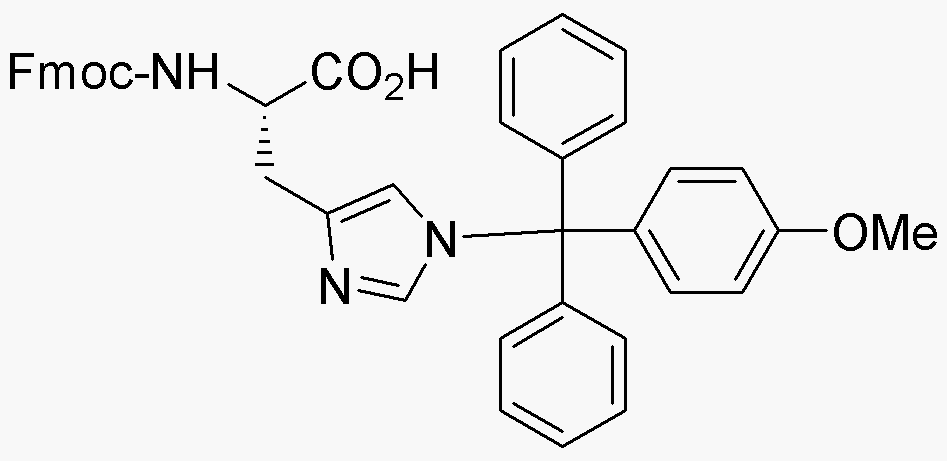Na-Fmoc-Nim-methoxytrityl-L-histidine is widely utilized in research focused on:
- Peptide Synthesis: This compound serves as a key building block in solid-phase peptide synthesis, enabling the creation of complex peptides with high purity and yield.
- Drug Development: It is used in the design of peptide-based therapeutics, particularly in oncology and immunology, where specific targeting of cancer cells is crucial.
- Bioconjugation: The chemical facilitates the attachment of peptides to various biomolecules, enhancing the efficacy of drug delivery systems and diagnostics.
- Research in Protein Engineering: It aids in the modification of histidine residues in proteins, allowing researchers to study protein function and interactions more effectively.
- Analytical Chemistry: The compound is employed in the development of analytical methods for detecting and quantifying peptides in biological samples, providing valuable insights into metabolic processes.
General Information
Properties
Safety and Regulations
Applications
Na-Fmoc-Nim-methoxytrityl-L-histidine is widely utilized in research focused on:
- Peptide Synthesis: This compound serves as a key building block in solid-phase peptide synthesis, enabling the creation of complex peptides with high purity and yield.
- Drug Development: It is used in the design of peptide-based therapeutics, particularly in oncology and immunology, where specific targeting of cancer cells is crucial.
- Bioconjugation: The chemical facilitates the attachment of peptides to various biomolecules, enhancing the efficacy of drug delivery systems and diagnostics.
- Research in Protein Engineering: It aids in the modification of histidine residues in proteins, allowing researchers to study protein function and interactions more effectively.
- Analytical Chemistry: The compound is employed in the development of analytical methods for detecting and quantifying peptides in biological samples, providing valuable insights into metabolic processes.
Documents
Safety Data Sheets (SDS)
The SDS provides comprehensive safety information on handling, storage, and disposal of the product.
Product Specification (PS)
The PS provides a comprehensive breakdown of the product’s properties, including chemical composition, physical state, purity, and storage requirements. It also details acceptable quality ranges and the product's intended applications.
Certificates of Analysis (COA)
Search for Certificates of Analysis (COA) by entering the products Lot Number. Lot and Batch Numbers can be found on a product’s label following the words ‘Lot’ or ‘Batch’.
*Catalog Number
*Lot Number
Certificates Of Origin (COO)
This COO confirms the country where the product was manufactured, and also details the materials and components used in it and whether it is derived from natural, synthetic, or other specific sources. This certificate may be required for customs, trade, and regulatory compliance.
*Catalog Number
*Lot Number
Safety Data Sheets (SDS)
The SDS provides comprehensive safety information on handling, storage, and disposal of the product.
DownloadProduct Specification (PS)
The PS provides a comprehensive breakdown of the product’s properties, including chemical composition, physical state, purity, and storage requirements. It also details acceptable quality ranges and the product's intended applications.
DownloadCertificates of Analysis (COA)
Search for Certificates of Analysis (COA) by entering the products Lot Number. Lot and Batch Numbers can be found on a product’s label following the words ‘Lot’ or ‘Batch’.
*Catalog Number
*Lot Number
Certificates Of Origin (COO)
This COO confirms the country where the product was manufactured, and also details the materials and components used in it and whether it is derived from natural, synthetic, or other specific sources. This certificate may be required for customs, trade, and regulatory compliance.


